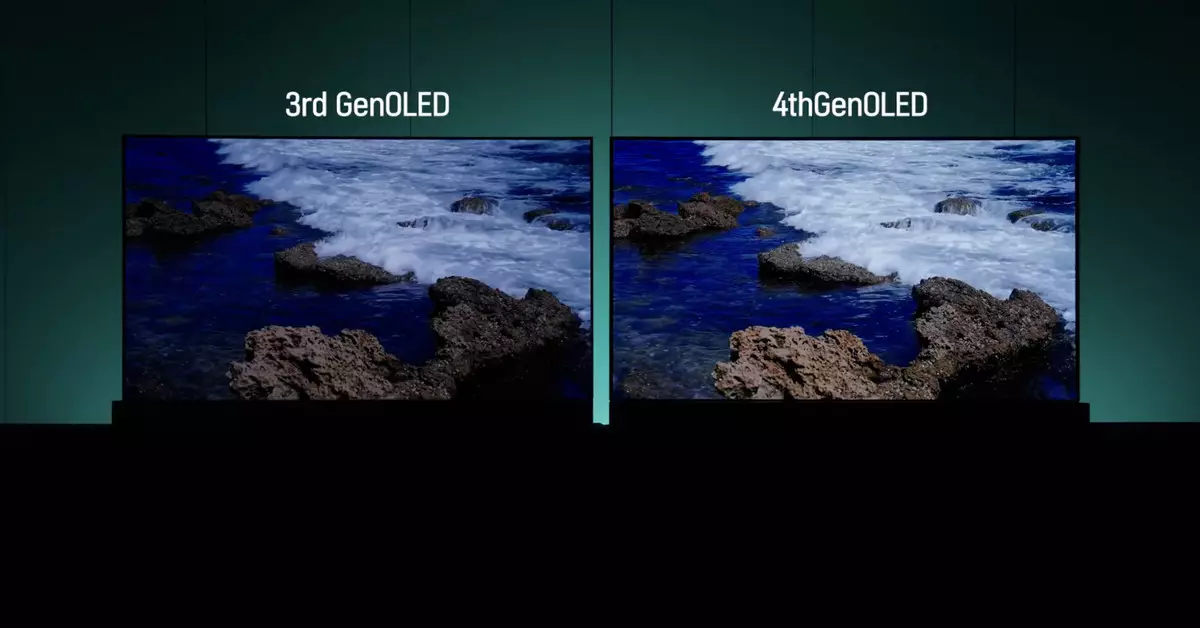The world of display technology is an ever-evolving arena where manufacturers continually strive to outdo each other in brightness, clarity, and color reproduction. One of the most significant advancements in recent years has come from OLED (Organic Light Emitting Diode) technology, which has revolutionized the way we experience visual media. Among the key players in this field, LG Display has long been at the forefront, though its presence at events like CES is not without scrutiny. This year, rather than showcasing its own innovations, LG’s advancements were highlighted through Panasonic’s presentations, raising questions about the company’s strategic direction in the competitive landscape.
Despite the absence of a grand exhibition, LG Display recently made a buzz-worthy announcement regarding its latest four-layer tandem OLED design. This new panel is crafted to achieve an impressive maximum brightness of 4,000 nits, which is a remarkable 33% brighter than its predecessor. Such brightness is not just a number; it signifies a leap forward in viewing experiences, particularly in well-lit rooms. The emphasis on this panel being optimized for the “AI TV era” did elicit some skepticism, but one cannot shy away from the fact that LG Display’s innovations are significant.
One of the most striking features of LG’s new OLED panel is its Primary RGB Tandem structure. This proprietary technology involves a detailed arrangement of RGB elements that allows more effective light production. Historically, LG used a three-stack system, which included varying layers of blue, red, and green elements. However, with the introduction of this fourth-generation structure, they’ve expanded this model to include additional layers of blue elements along with individually organized red and green layers. This specialized configuration harnesses more light, leading to increased maximum brightness and enhanced visual brilliance.
In light of this OLED brightness war—pitting LG against Samsung’s QD-OLED technology—it’s compelling to see where LG is positioning itself. While Samsung has opted for a glare-free display experience, LG maintains a more traditional glossy finish, supplemented with “ultra-low reflective technology” to mitigate distractions during viewing. This approach can appeal to consumers who prefer vibrant colors inherent in glossy displays while offering practical solutions to minimize reflections.
Efficiency and Performance Enhancements
Beyond mere brightness, LG Display has also focused on energy efficiency with its fourth-generation OLED panels. The latest displays demonstrate a 40% improvement in color brightness, reaching impressive figures like 2,100 nits. However, these technical capabilities may not fully translate when implemented in consumer-ready televisions, as manufacturers like Panasonic often exercise discretion in maximizing panel capabilities to ensure longevity and reliability.
While the benefits of OLED technology—namely perfect blacks, exceptional viewing angles, and rapid response times—remain at the forefront of consumer interest, the mounting cost of these premium products is a consideration that buyers must evaluate. The combination of pioneering features and the inherent quality of OLED displays makes them attractive for dedicated enthusiasts, though the price point may necessitate careful budgeting.
As the landscape of television technology continues to evolve, consumer expectations will undoubtedly rise. Audiences are increasingly drawn to vivid, dynamic content, pushing companies to innovate continuously. LG Display’s emphasis on brightness, color accuracy, and viewer experience aligns well with evolving consumer demands and sets a robust stack against competitors in the OLED arena.
Moreover, the narrative extends to what these developments mean for the average consumer. As manufacturers like Panasonic prepare their flagship models equipped with LG’s latest innovations, potential buyers can anticipate a new wave of products that promise to deliver unparalleled viewing experiences. Enthusiasts looking for a combination of superior image quality and aesthetic appeal will find themselves at a crossroads—balancing desire with investment.
LG Display’s recent advancements signal noteworthy progress in OLED technology. As competition heats up between industry giants, the challenge will be not just to create brighter and better screens, but to do so in ways that resonate with consumer priorities for efficiency, cost, and stunning visual effects. The future of OLED technology looks promising, and both consumers and companies will benefit from the ongoing innovation in this field.

